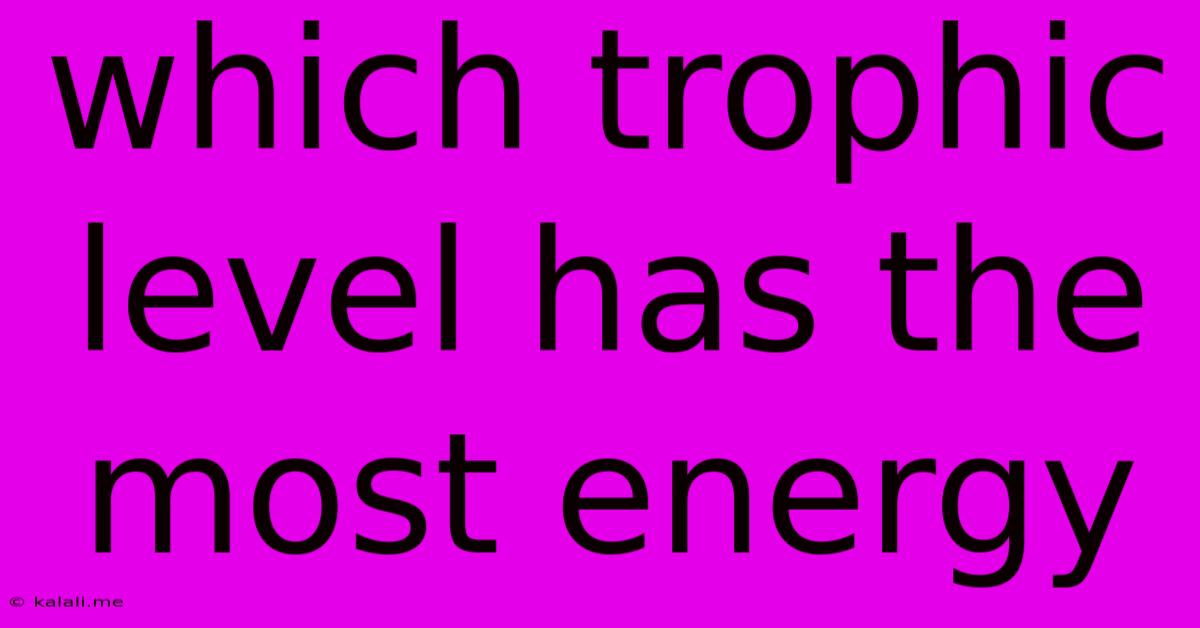Which Trophic Level Has The Most Energy
Kalali
Jun 14, 2025 · 3 min read

Table of Contents
Which Trophic Level Has the Most Energy? Understanding Energy Flow in Ecosystems
Meta Description: Discover which trophic level boasts the highest energy concentration in an ecosystem. This article explains energy transfer in food chains and the impact on biodiversity. Learn about producers, consumers, and decomposers and their role in energy flow.
The question of which trophic level holds the most energy is a fundamental concept in ecology. It's tempting to think of apex predators, like lions or sharks, as the most energetic, but the reality is far more nuanced. The answer lies in understanding how energy flows through an ecosystem.
The Foundation: Producers and the First Trophic Level
The trophic level with the most energy is the first trophic level, which consists of producers. These are primarily plants and other photosynthetic organisms that harness energy from the sun through photosynthesis. This energy is stored as chemical energy in the form of sugars and other organic molecules. This process is crucial because it's the initial source of energy for virtually all other life forms within an ecosystem. Think of it as the base of the energy pyramid. This level has the highest biomass and the largest amount of stored energy.
The Energy Pyramid: A Visual Representation
The energy pyramid, or sometimes called the ecological pyramid, is a useful model to visualize energy flow. It demonstrates that energy decreases as it moves up the food chain. Each level represents a trophic level, with producers forming the base. Only about 10% of the energy from one trophic level is transferred to the next. This is due to several factors, including:
- Energy Loss through Respiration: Organisms use a significant portion of their energy for metabolic processes, like respiration, movement, and maintaining body temperature.
- Energy Loss as Heat: Energy is constantly lost as heat during metabolic processes.
- Inefficient Consumption: Not all of an organism is consumed by the next trophic level. Parts might be left uneaten or indigestible.
Consumers and Decomposers: Energy Transfer Up the Chain
The second trophic level includes primary consumers, herbivores that feed on producers. They receive only a fraction of the initial energy stored in the producers. This continues up the chain with secondary consumers (carnivores that eat herbivores), tertiary consumers (carnivores that eat other carnivores), and so on. Each successive level has progressively less energy available.
Decomposers, like bacteria and fungi, are crucial in breaking down dead organic matter from all trophic levels. They recycle nutrients back into the ecosystem, making them available for producers. While not directly part of the energy pyramid in the same way as consumers, they are essential for the continuous flow of energy and nutrients.
Biomass and Energy: A Key Distinction
It's important to distinguish between biomass and energy. While the first trophic level has the highest biomass (the total mass of living organisms), it's the energy content that's the key factor in determining which level has the most energy. Because of the significant energy loss at each trophic level, producers always hold the greatest energy reservoir.
Conclusion: The Power of Producers
In conclusion, the trophic level with the most energy is unequivocally the first trophic level – the producers. Their ability to capture solar energy through photosynthesis forms the foundation of all ecosystems, providing the base energy for all other life forms. Understanding this fundamental concept is critical to appreciating the interconnectedness and delicate balance within any ecosystem.
Latest Posts
Latest Posts
-
How To Make 35 In Roman Numerals
Jun 15, 2025
-
Difference Between Perfect Competition And Monopolistic Competition
Jun 15, 2025
-
At What Temperature In Fahrenheit Does Water Freeze
Jun 15, 2025
-
What Portion Of The Electromagnetic Spectrum Is Visible
Jun 15, 2025
-
Dot Over I And J Called
Jun 15, 2025
Related Post
Thank you for visiting our website which covers about Which Trophic Level Has The Most Energy . We hope the information provided has been useful to you. Feel free to contact us if you have any questions or need further assistance. See you next time and don't miss to bookmark.